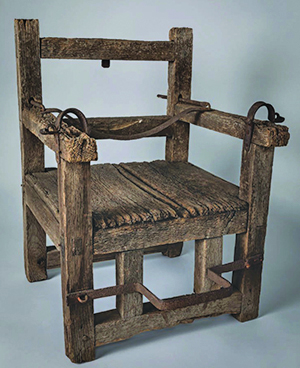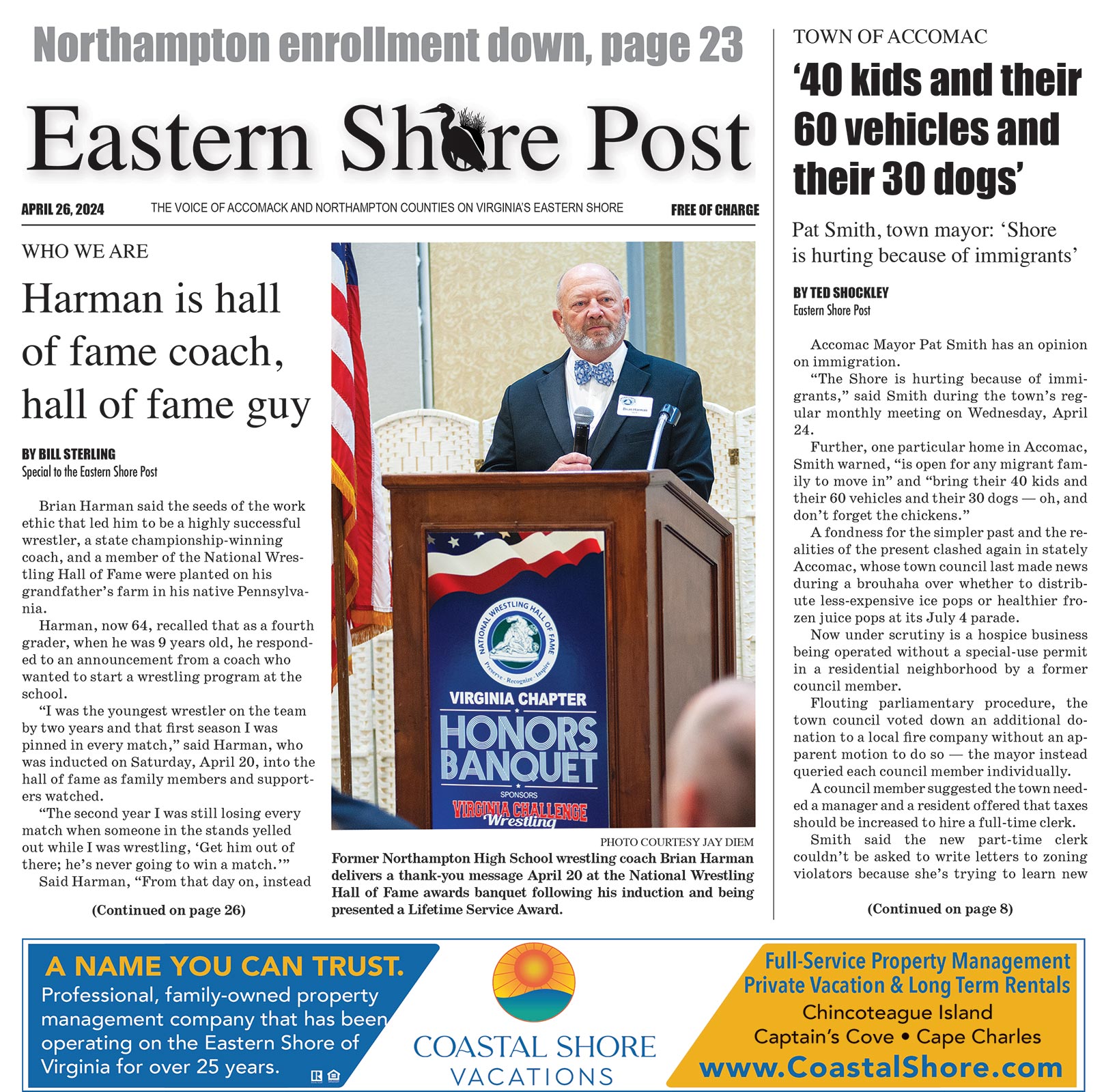By Martha Steger
Special to the Eastern Shore Post
Imagine an early 17th-century woman in England making the decision to travel across the Atlantic Ocean to an unknown land: The question, “Should I go, or should I stay?” is an eye-catching, thought-provoking introduction to Jamestown Settlement’s new exhibition, “Tenacity: Women in Jamestown and Early Virginia.” The decisions the women made more than 400 years ago helped shape democracy, diversity, and the notion of opportunity in what became the United States.
They first came as two brave Englishwomen in the fall of 1608 – Mistress Forest, who traveled with her husband but shortly died, leaving her 14-year-old handmaid, Anne Burras, as the only woman among an estimated 198 men at James Fort. Other women were Indians in the Powhatan Confederation, who helped the first permanent English colonists in the New World survive with baskets and ceramic bowls of foodstuffs — though Indian women later faced abduction and enslavement as Englishmen broke their own laws guarding against such actions.
Important artifacts, interactive text, and reenacted conversations and thoughts of 17th-century women in videos are part of the 400th anniversary commemoration of significant 1619 Virginia events; the exhibition will last through 2019. It brings to life some of the dynamic women from different cultures who proved indispensable to the settlement at Jamestown — women such as Cockacoeske, queen of the Pamunkey; and Elizabeth Dunthorne, one of very few female planters who qualified through her indenture for 100 acres of land (though under law, her husband could assume control of his wife’s holdings).
Two Early Eastern Shore Women
Betsey Tucker and Mary Johnson, Caucasian and African respectively, were two of the women arriving in 17th century Jamestown, who later settled on the Eastern Shore. Little is known of Tucker other than a 1634 Hungars Parish record showing punishment for “brabbling” or gossiping. Offenders – usually women – were strapped to a sturdy chair, which was fastened to a long wooden beam, and dunked into a body of water – “the pond” as the record reads for Tucker’s case.
The practice of ducking was common in England and America from the early 17th to 19th centuries. The fourth person to use the chair that summer, Tucker reportedly ducked five times, surviving the public humiliation. A traditional 17th century ducking chair in Jamestown-Yorktown Foundation’s collection is on display in the exhibition. Nothing more is known of Tucker.
More is known about Johnson, an African arriving in 1623 who worked on the Southside Virginia plantation owned by Richard Bennett. There she met and married Antonio (Anthony) Johnson. By the 1640s, both had gained their freedom and settled in Northampton County (originally part of what the English called “Accomac Shire”).
The couple acquired their first land patent for 250 acres in 1650; over the next four years, their sons acquired 650 acres, bringing the size of their family plantation to 900 acres. Two Africans, John Casar and Mary Gersheene, are documented as serving in the Johnson household. As laws in Virginia were becoming more restrictive for Africans by the late 1650s, the Johnsons moved to Somerset County, Md., and leased 300 acres on which they established a plantation, “Tonies Vineyard.”
“Myne Owne Ground,” a book by professors T.H. Breen and Stephen Innes (Northwestern and University of Virginia, respectively), provides detailed information on the first Africans who settled on the Eastern Shore. Many of those who arrived in slavery later achieved freedom and formed a stable community on the Shore, holding their own with white neighbors for most of the 17th century. (The book provides a look at why this model of social interaction in race relations did not survive.)
Onward from 1608
After 1608, a few more women arrived as wives and maids the following summer. Undaunted women survived shipwrecks — like those in Bermuda, where John Rolfe’s first wife probably died following the birth of the baby they named Bermuda after crossing stormy seas.
They often not only survived but thrived: In the first marriage in Virginia, Anne Burras married John Laydon in 1610 and had a family of four daughters. Population numbers recorded six years later by John Rolfe (the widower who married Pocahontas in 1614) show that of 351 persons, a fifth of the population — 65 — were women and children.
As with so many of the men, many of the women died, especially during the starving time — winter 1609-10, when settlers ate whatever they could find, including bark and shoe leather. Remains found and subsequent forensic examination in 2012 of an anonymous “Jane” at Historic Jamestowne’s original site — adjacent and complementary to Jamestown Settlement — illustrate a woman’s life lost to illness who helped others live. Settlers ate her flesh for their survival during the extraordinarily difficult period, when only 60 persons survived out of the population of 350. (Jane’s bones are displayed at Historic Jamestowne’s Archaearium.)
As commentary on the dire times, Jamestown Settlement historian Nancy Egloff cites the writings of William Strachey, who was part of the 1609 group shipwrecked on the Sea Venture in Bermuda and who arrived in Virginia in spring 1610: “Viewing the fort, we found the palisades torn down … gates from off the hinges, and empty houses. … And it is true the Indian killed as fast without, if our men stirred but beyond the bounds of their blockhouse, as famine and pestilence did within.”
In 1618 a London leadership shake-up in the Virginia Company, which had underwritten the colony and watched it flounder since 1607, resulted in the ideas of allowing limited land ownership and the creation of families to make the colony more settled. Some women — vagrants and miscreant ‘strumpets’ from prisons and work-houses such as London’s notorious Bridewell — came as workers.
Records show 32 Africans, 17 of them women, also working in the colony before groups of women started coming in 1620-21 as wives to men who paid for their passage. The first census, in early 1620, indicates 119 English women — many probably indentured servants to work between four and seven years in the Virginia Company tobacco fields along with 670 men.
An interactive experience — formatted similarly to 21st century online review sites — engages visitors with positive and negative reviews of 17th century Virginia: these are humorous star ratings based on actual quotes from the time period, which we can explore with the touch of an icon. The Jamestown “reviews” function as a connection for present day travelers to 17th century Virginia. A 1623 one-star review reads, “The houses are garbage,” while another gives the housing four stars. A three-star comment on Virginia weather says, “I don’t know what people are complaining about, the weather is fine once you get used to it.”
Along with the Jamestown-York-town’s collection of 17th century artifacts — including a child’s high chair and the ducking chair referenced earlier — the special exhibition features more than 60 artifacts on loan from 22 international and national institutions. Among the most engaging is an unfitted jacket on loan from London’s Victoria and Albert Museum and dating to 1605-1620, likely worn as 17th century maternity wear and illustrating stories of English women pregnant during their voyage across the Atlantic to the New World. A long-sleeved bodice, circa 1610, courtesy of the Shakespeare Birthplace Trust, features an embroidered design of trailing stems and leaves worked in colored silk and metal threads with metal spangles or sequins and illustrates the apparel of governors’ wives or women aspiring to an upper class.
The Legacy of Early Virginia Women
Before leaving the exhibition, visitors shouldn’t miss the touch-screen Legacy Wall, which helps connect the stories of women from 1607 to the present day in five themes — occupation, citizenship, marriage, education, and healthcare. Anyone can share stories of influential women across history, including those in their own lives and families, and add them to the wall.
2018’s first season of the “Jamestown” television series, which premiered in the United Kingdom, sought to capture the horrors without and within the colony. Historic Jamestowne senior curator Bly Straube blogged about the series, connecting themes in the show to themes explored in the new exhibition. (See box for links to the eight blogs related to the TV series.) U.K. journalists visited Jamestown Settlement and Historic Jamestowne to promote travel to the Jamestown sites. The first season recently appeared in the U.S. on a PBS Masterpiece Amazon channel and on PBS Passport, which requires subscription. No information is forthcoming regard-ing the launch of the second season in the U.S.; it was not filmed here.
Information at https://historyisfun. org/tenacity/, 888-593-4682 or 757-253-4838. 2018 admission is $17 adults, $8 ages 6-12 (2019: $17.50 adults, $8.25 ages 6-12), and free for children under 6. A value-priced combination ticket to Jamestown Settlement and the American Revolution Museum at Yorktown is $25.50 adults, and $12.25 ages 6-12 (2019: $26 adults, $12.50 ages 6-12).
www.HistoricJamestowne.org or 757-856-1250. 2018 admission is $14 adults aged 16 and older; 15 and under, free (2019: $20 adults, 15 and under, free).
Sign in
Welcome! Log into your account
Forgot your password? Get help
Password recovery
Recover your password
A password will be e-mailed to you.



